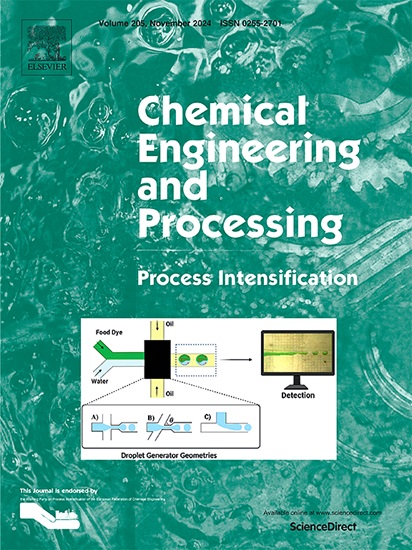Design and optimization of etherification reaction-assisted separation process for dimethyl carbonate/methanol azeotrope system
IF 3.8
3区 工程技术
Q3 ENERGY & FUELS
Chemical Engineering and Processing - Process Intensification
Pub Date : 2025-03-29
DOI:10.1016/j.cep.2025.110293
引用次数: 0
Abstract
Dimethyl carbonate (DMC) has high commercial value as an important raw material for diesel. Aiming at the industry problem of high energy consumption in DMC/methanol (MeOH) azeotrope separation, a new idea of MeOH/DMC azeotropic system with mixed C4 etherification reaction-assisted separation was proposed for the first time in this study. The process couples the transesterification segment of ethylene carbonate (EC) with the etherification segment of methyl tert-butyl ether (MTBE), which breaks the azeotropic state of MeOH and DMC by inducing the reaction of MeOH with isobutylene to produce MTBE. First, the kinetic parameters of the transesterification and etherification reactions were investigated. Then the process was designed and simulated in Aspen Plus. Finally, in order to further recover the waste heat of the reaction section, the optimal configuration of steam-driven heat pump coupled with Rankine cycle was designed. The results showed that the EC conversion reached 100 %, the purity of DMC and MTBE reached 99.99 % and 99.5 %, respectively, and the total energy consumption, environmental pollutant emission and TAC were reduced by 36.0 %, 40.0 % and 32.7 %, respectively, compared with that of the original conventional process.

碳酸二甲酯/甲醇共沸体系醚化反应辅助分离工艺设计与优化
碳酸二甲酯(DMC)作为重要的柴油原料具有很高的商业价值。针对工业上DMC/甲醇(MeOH)共沸体系分离能耗高的问题,首次提出了混合C4醚化反应辅助分离的MeOH/DMC共沸体系的新思路。该工艺将碳酸乙烯酯(EC)的酯交换反应段与甲基叔丁基醚(MTBE)的醚化反应段偶联,通过诱导甲醇与异丁烯反应生成MTBE,打破甲醇与DMC的共沸状态。首先,研究了酯交换反应和醚化反应的动力学参数。然后在Aspen Plus中对该工艺进行了设计和仿真。最后,为了进一步回收反应段的余热,设计了蒸汽驱动热泵与朗肯循环耦合的优化配置。结果表明,该工艺的EC转化率达到100%,DMC和MTBE的纯度分别达到99.99%和99.5%,总能耗、环境污染物排放量和TAC分别比原常规工艺降低36.0%、40.0%和32.7%。
本文章由计算机程序翻译,如有差异,请以英文原文为准。
求助全文
约1分钟内获得全文
求助全文
来源期刊
CiteScore
7.80
自引率
9.30%
发文量
408
审稿时长
49 days
期刊介绍:
Chemical Engineering and Processing: Process Intensification is intended for practicing researchers in industry and academia, working in the field of Process Engineering and related to the subject of Process Intensification.Articles published in the Journal demonstrate how novel discoveries, developments and theories in the field of Process Engineering and in particular Process Intensification may be used for analysis and design of innovative equipment and processing methods with substantially improved sustainability, efficiency and environmental performance.

 求助内容:
求助内容: 应助结果提醒方式:
应助结果提醒方式:


